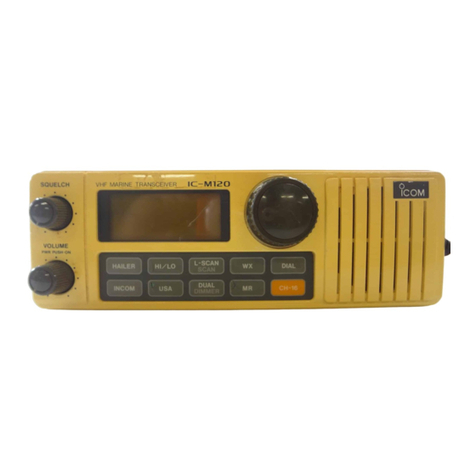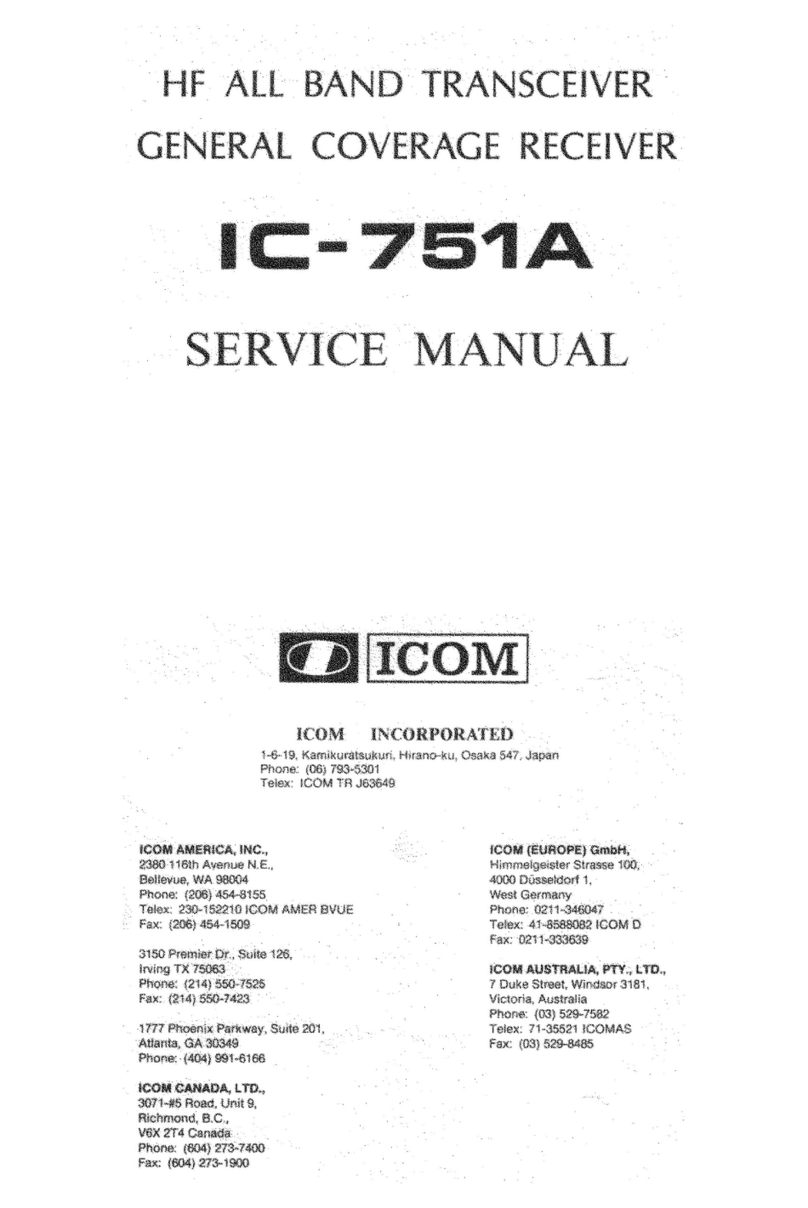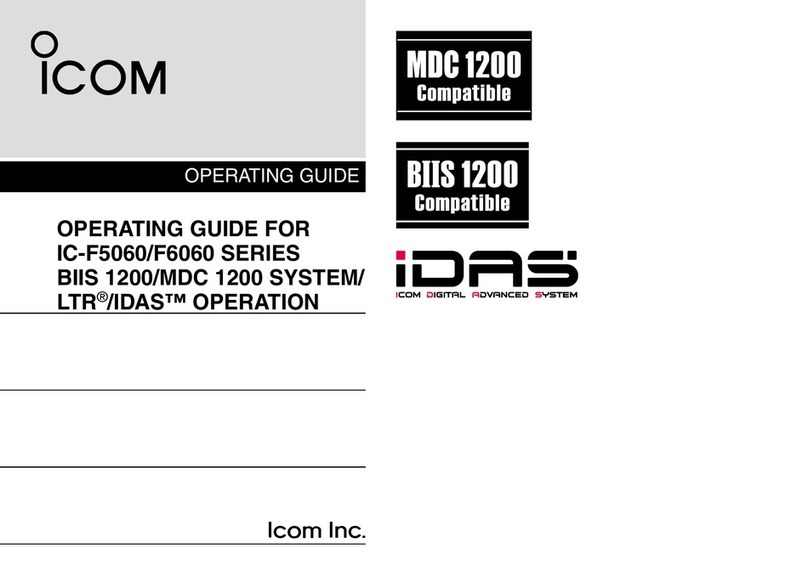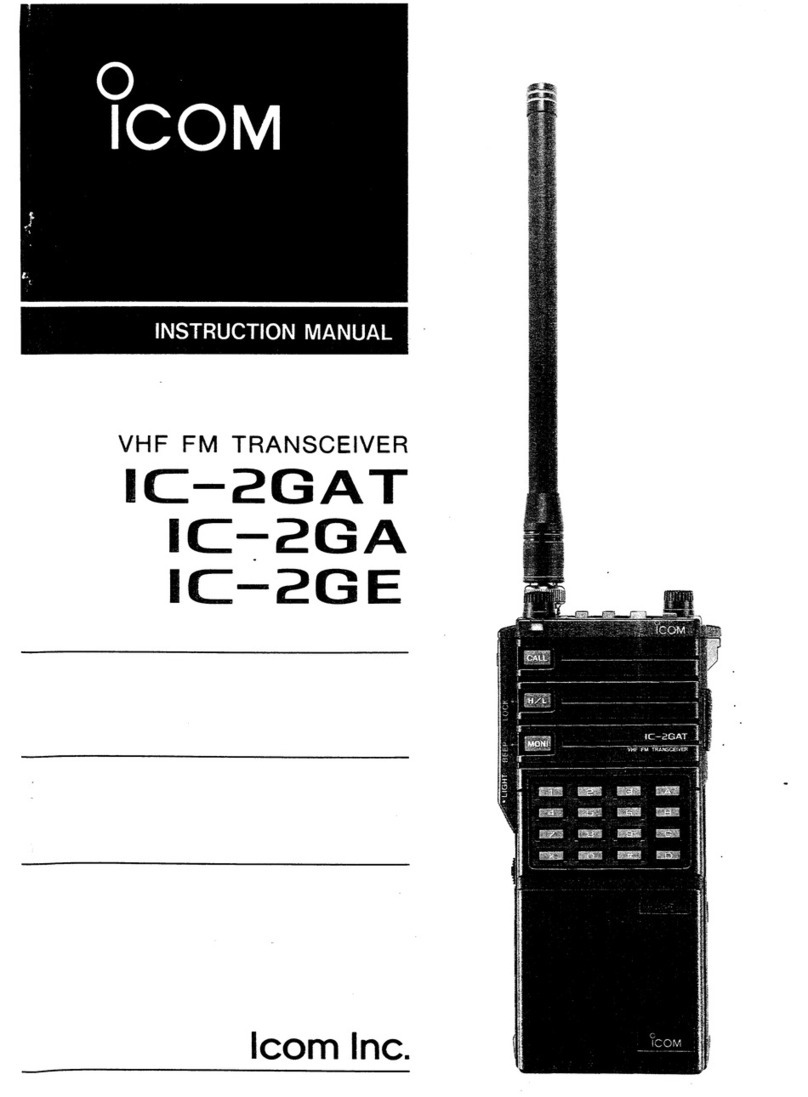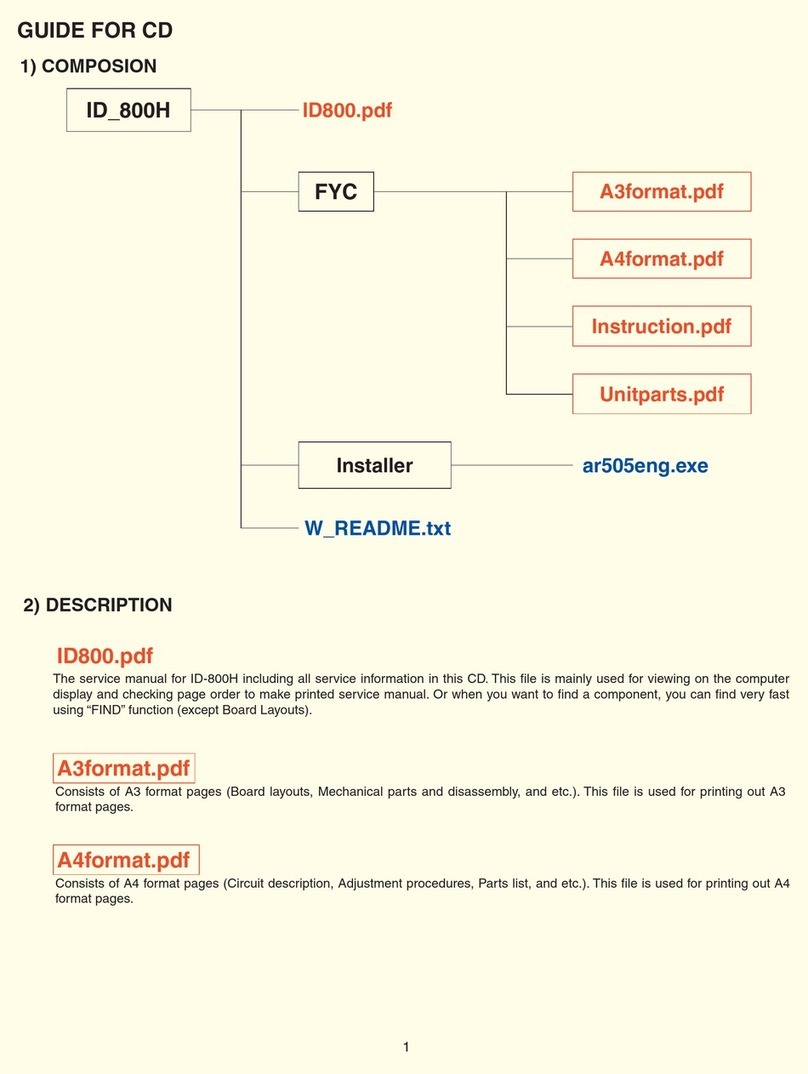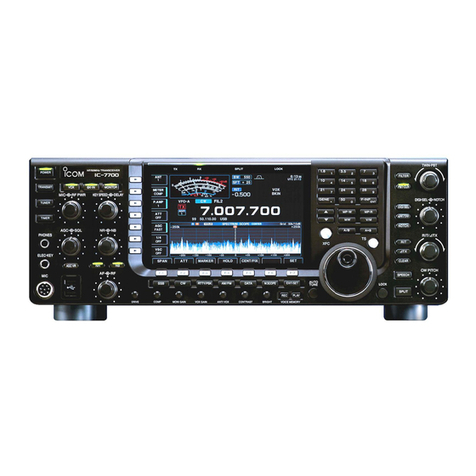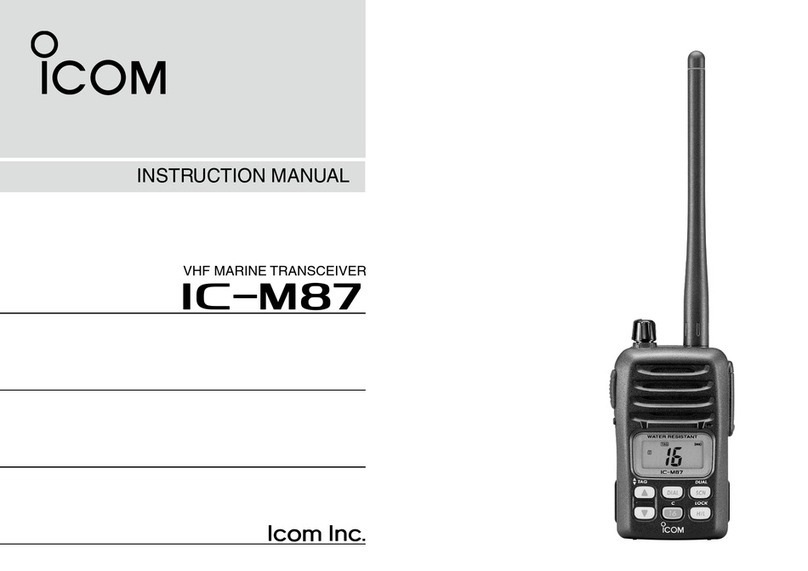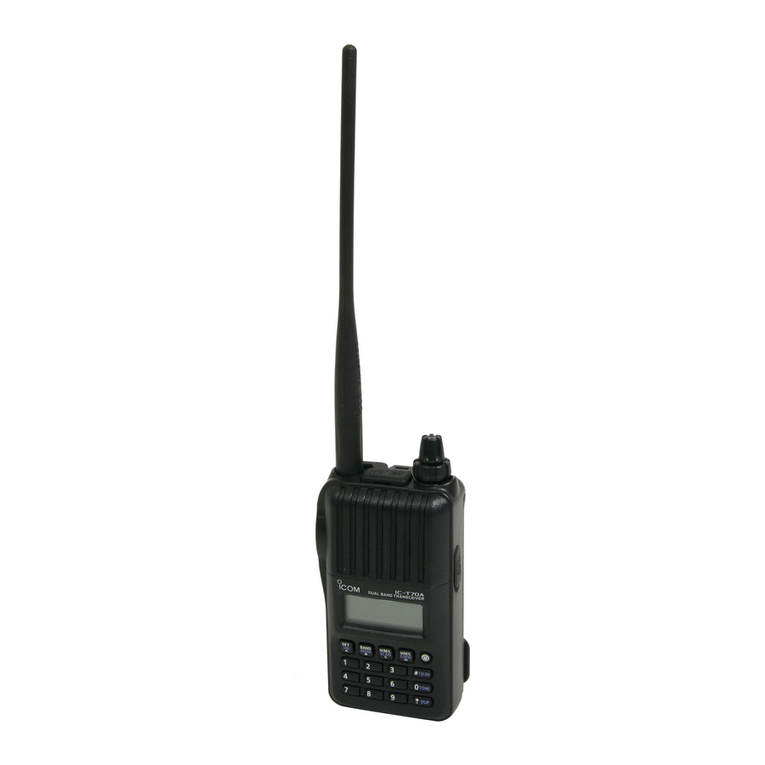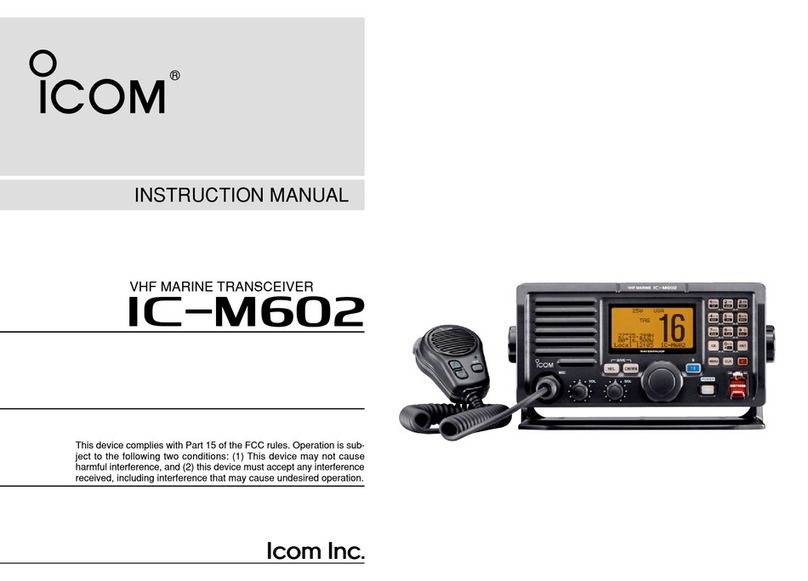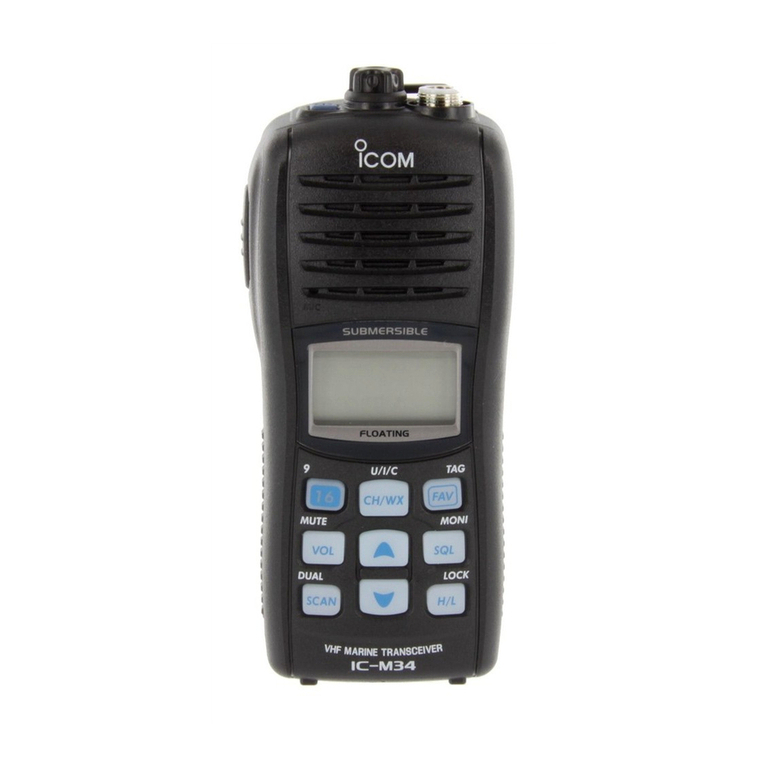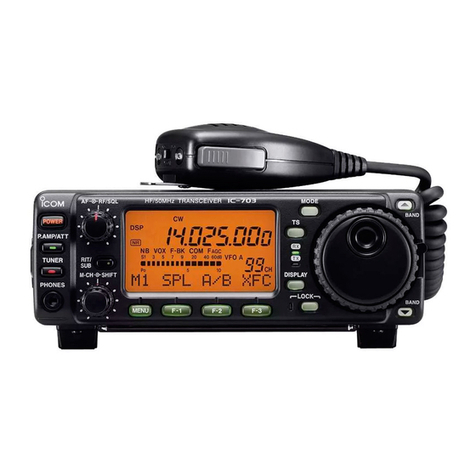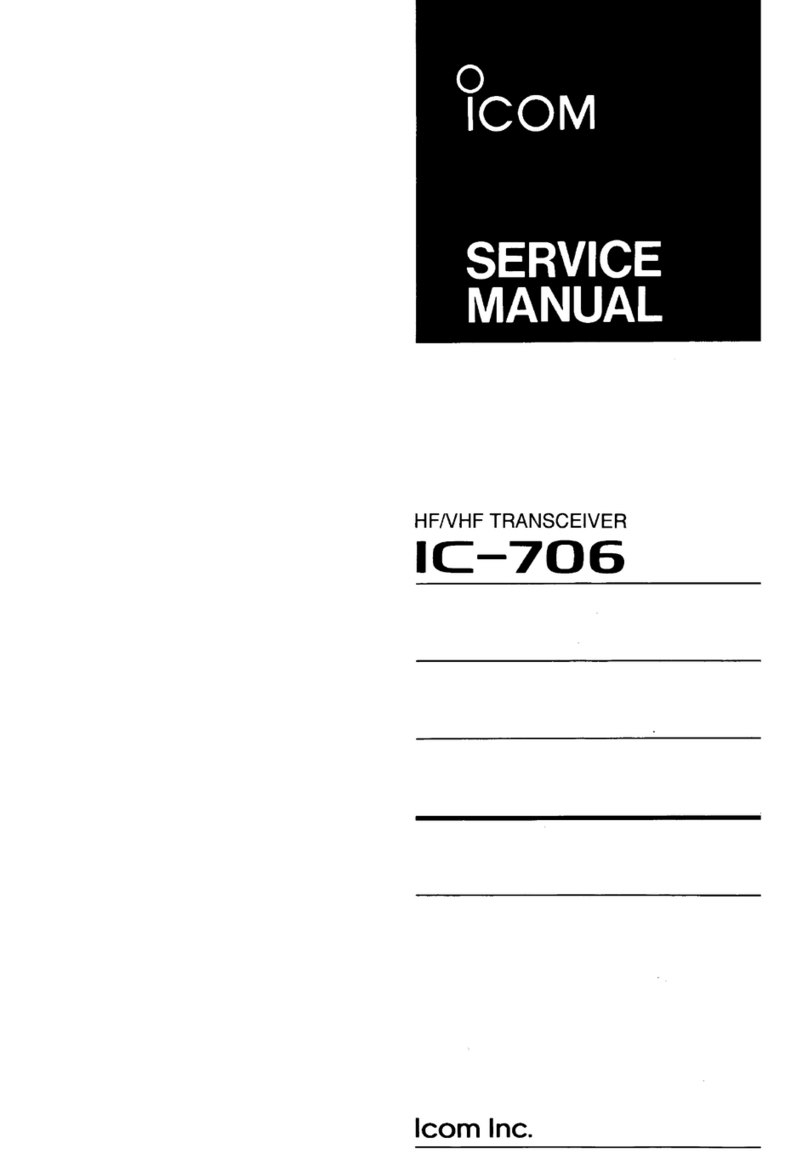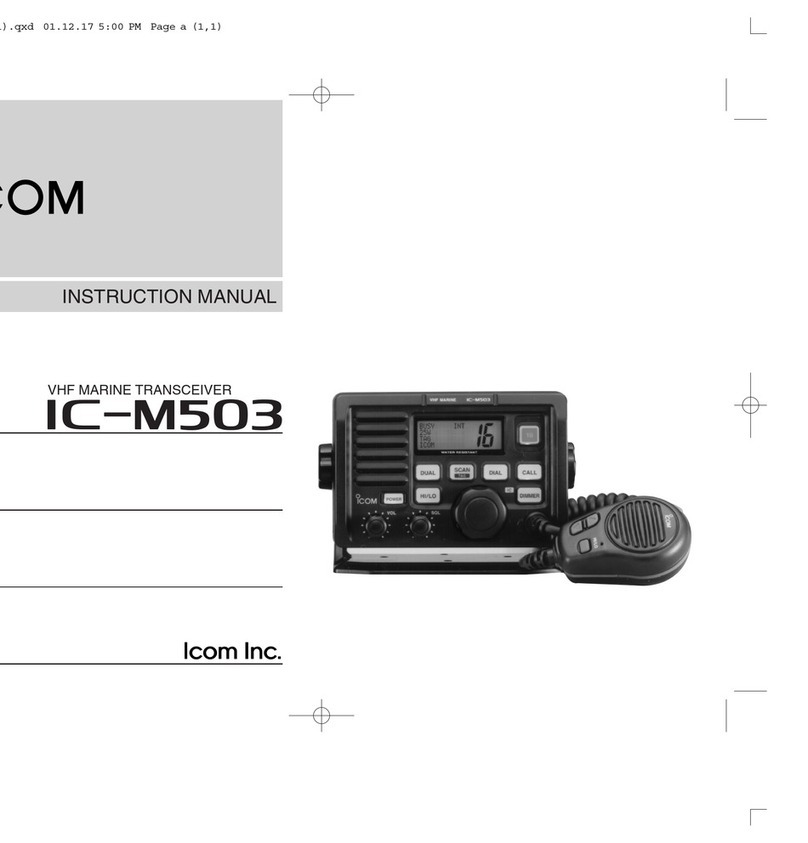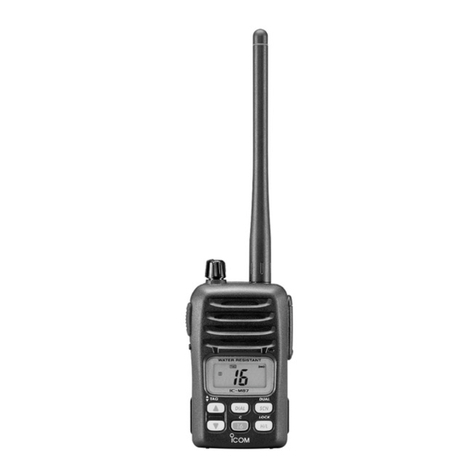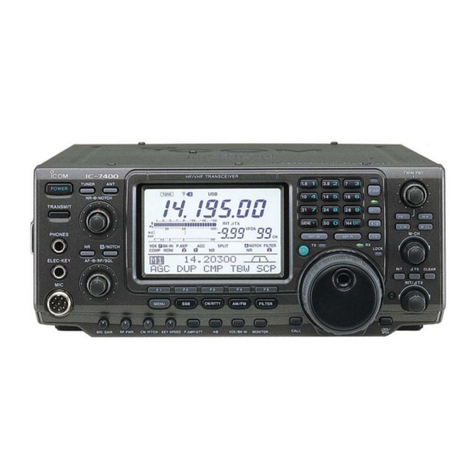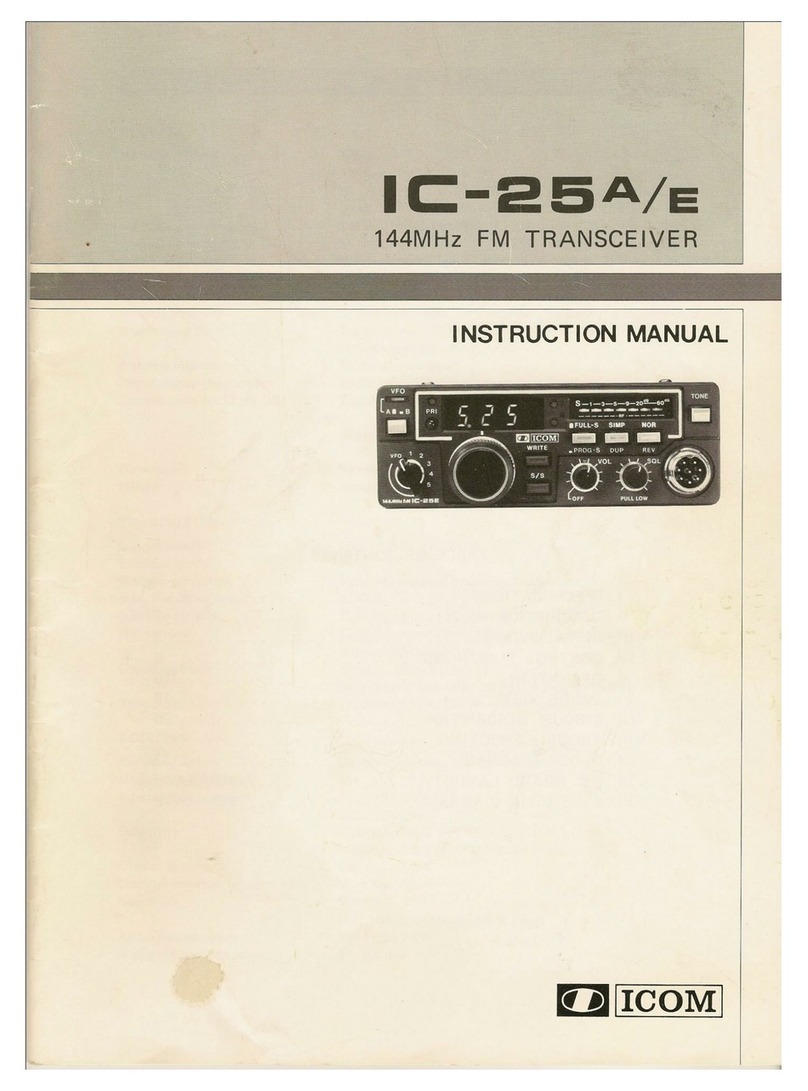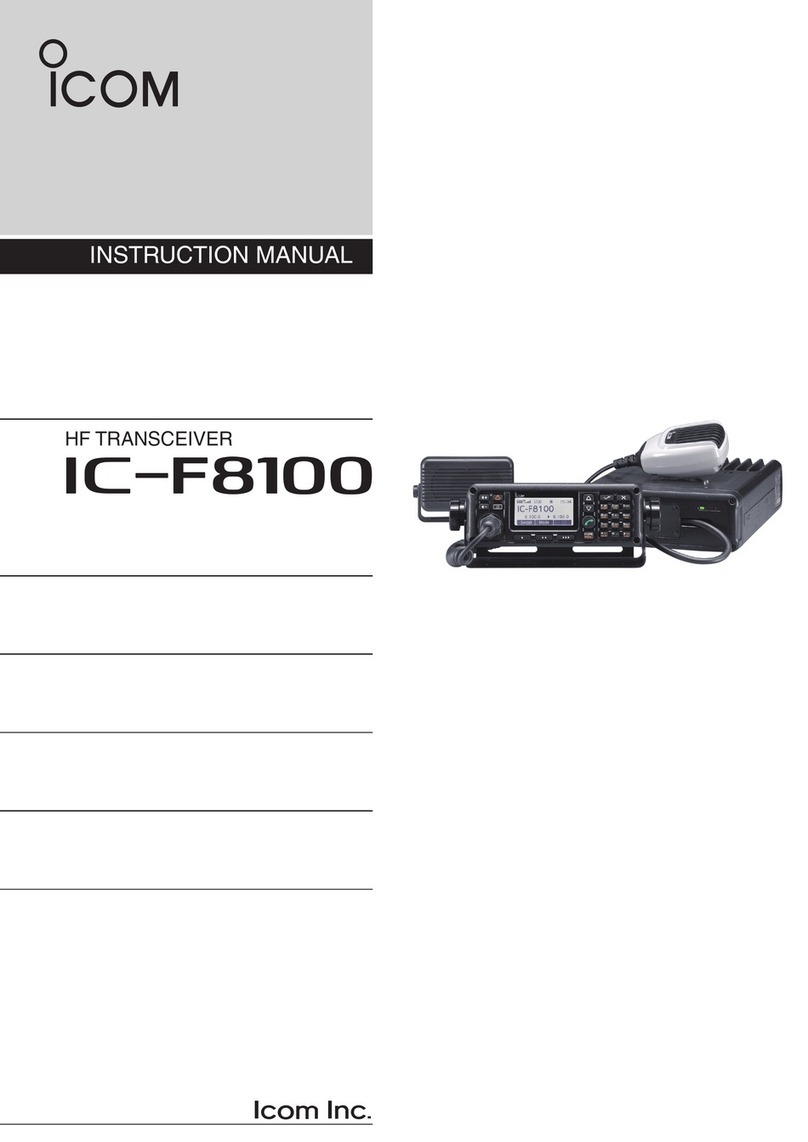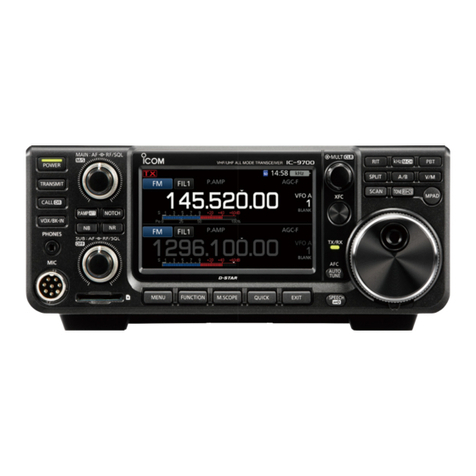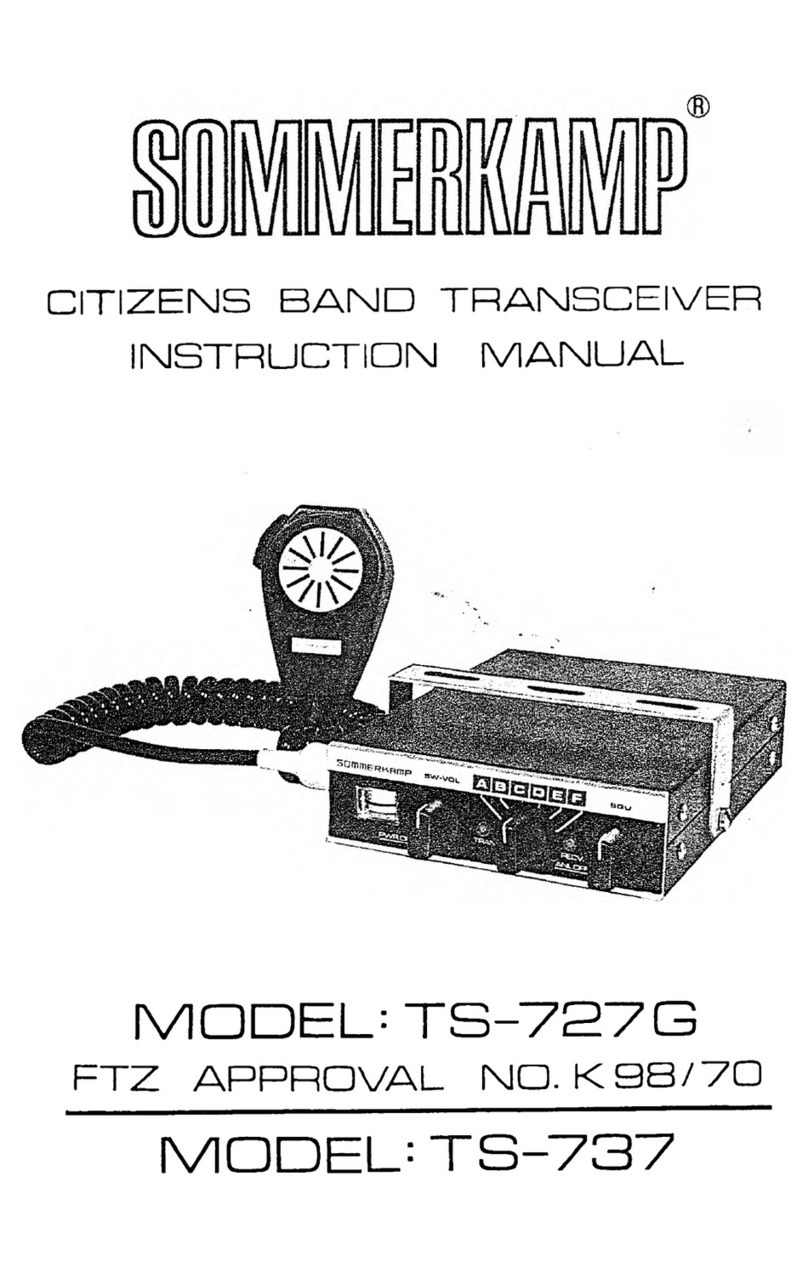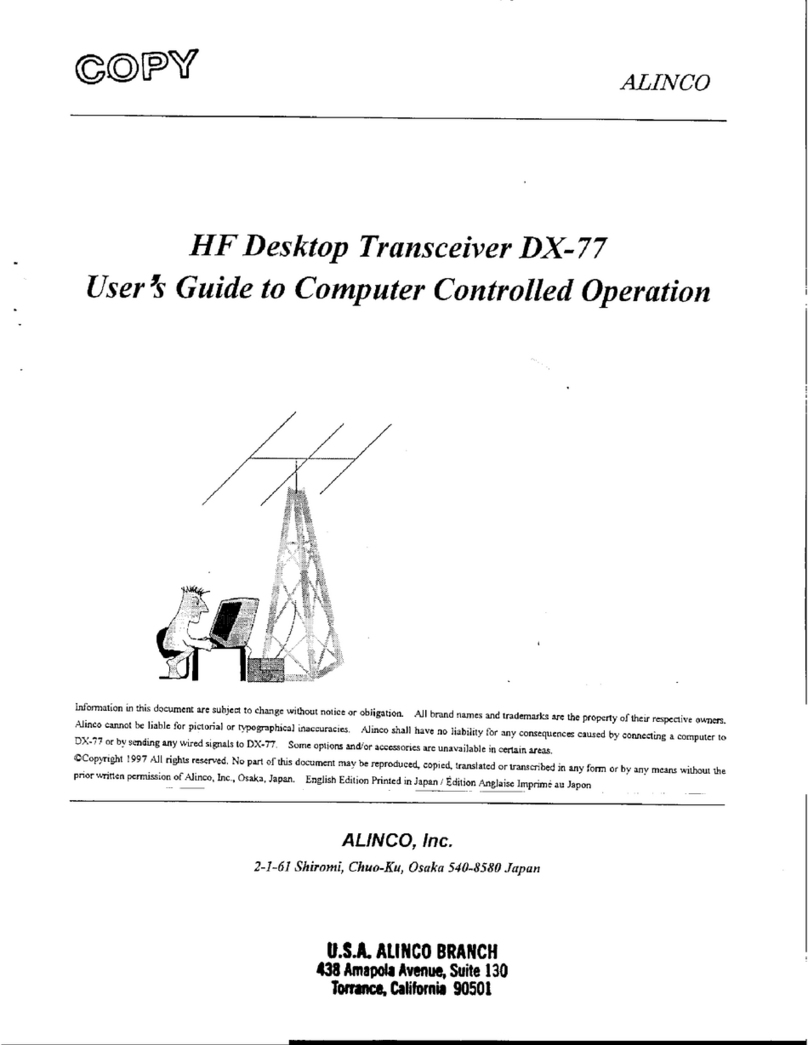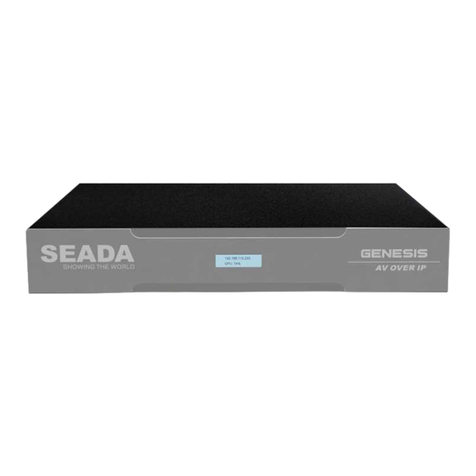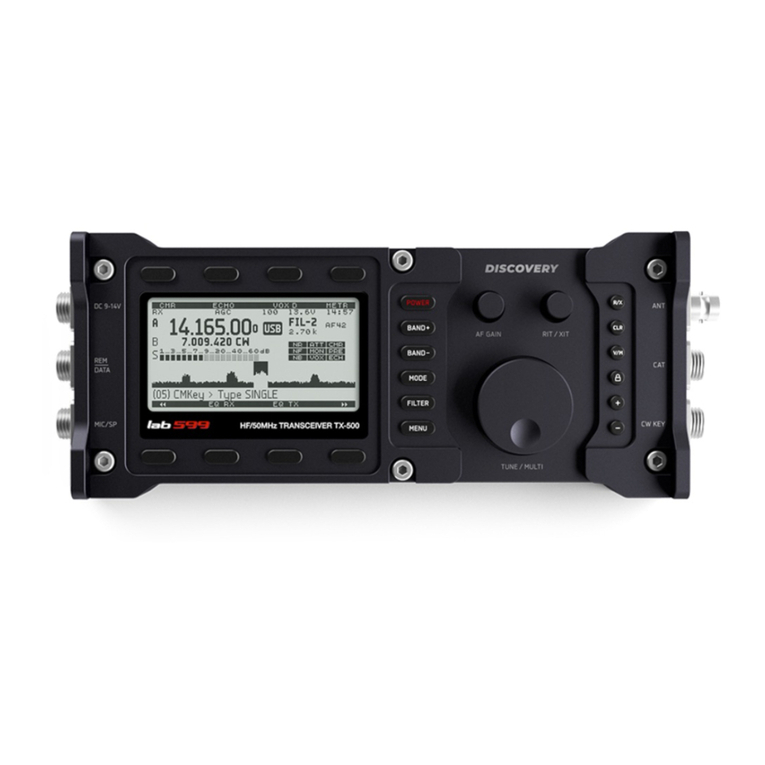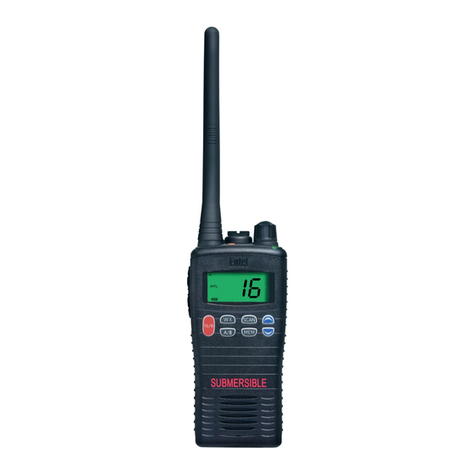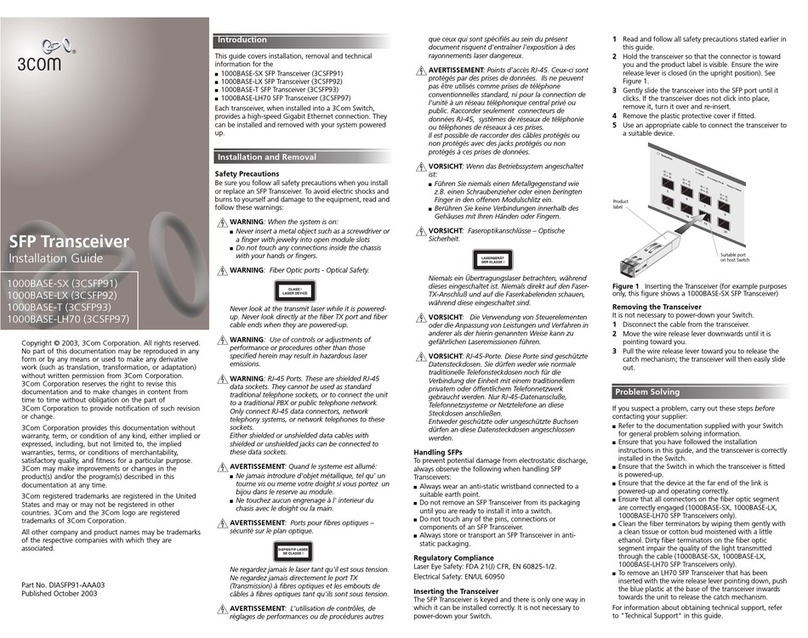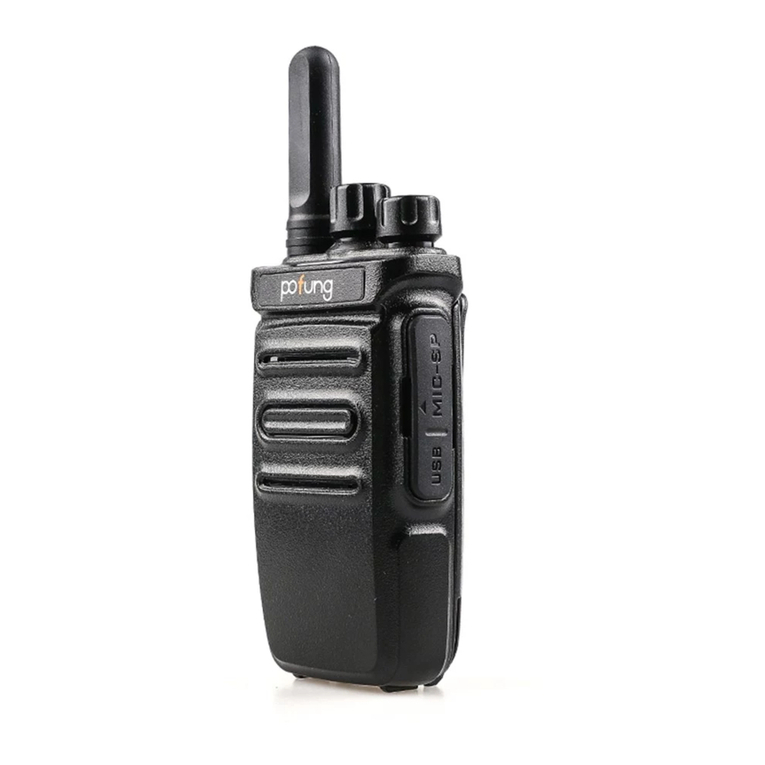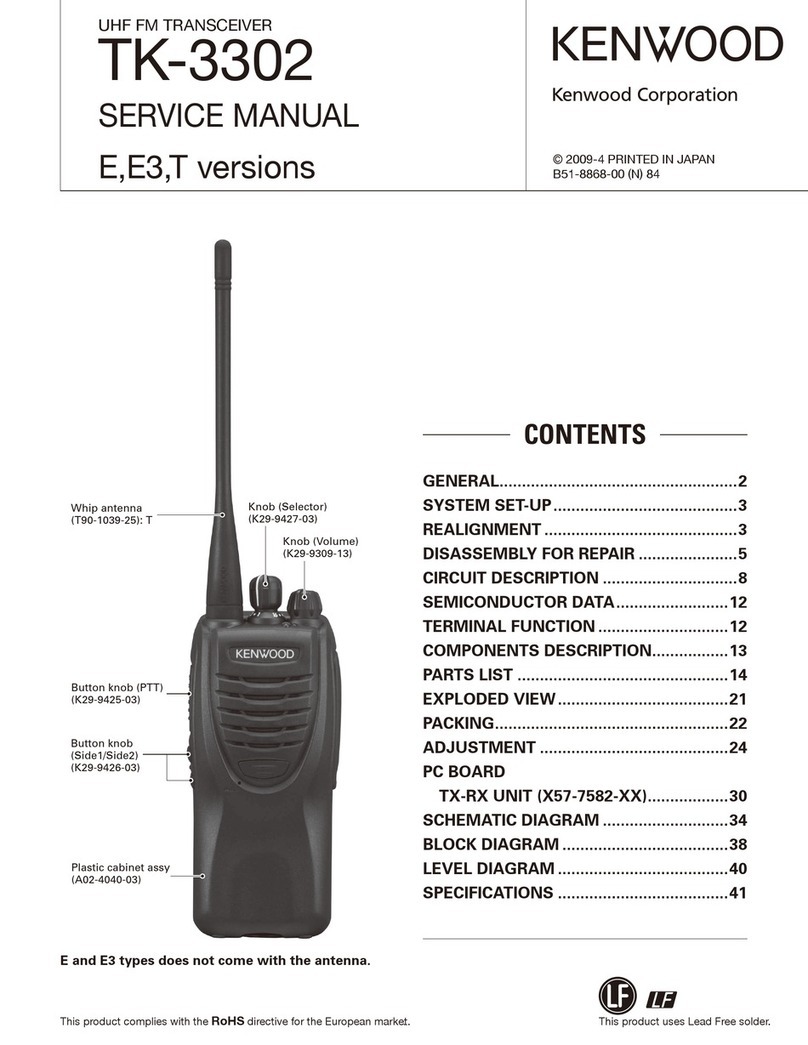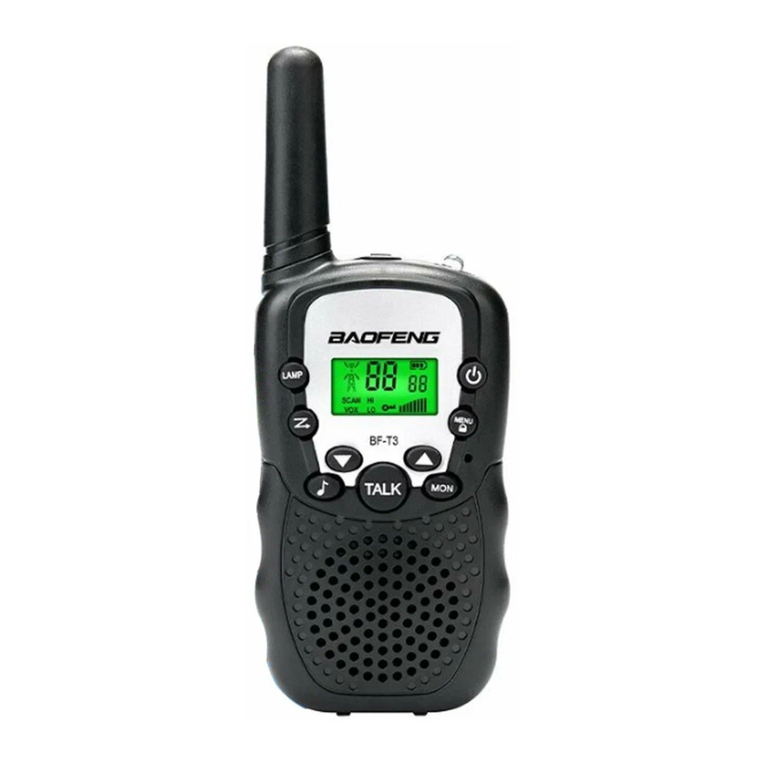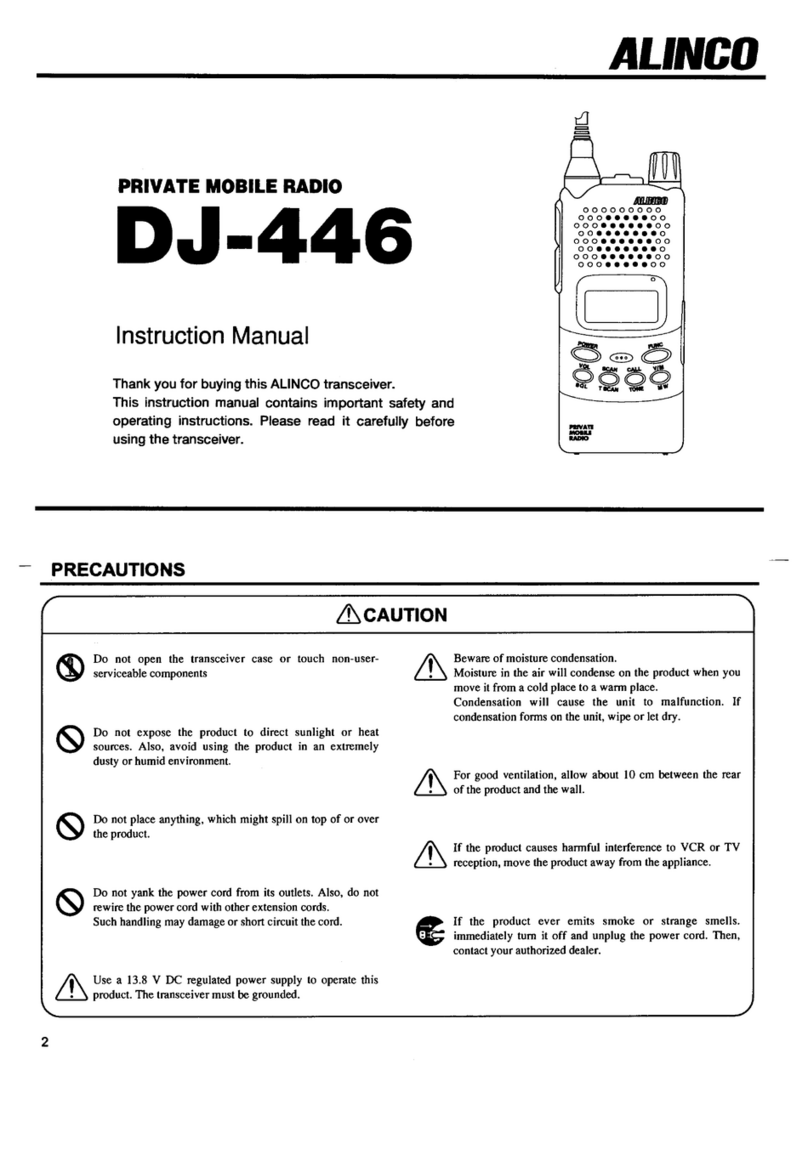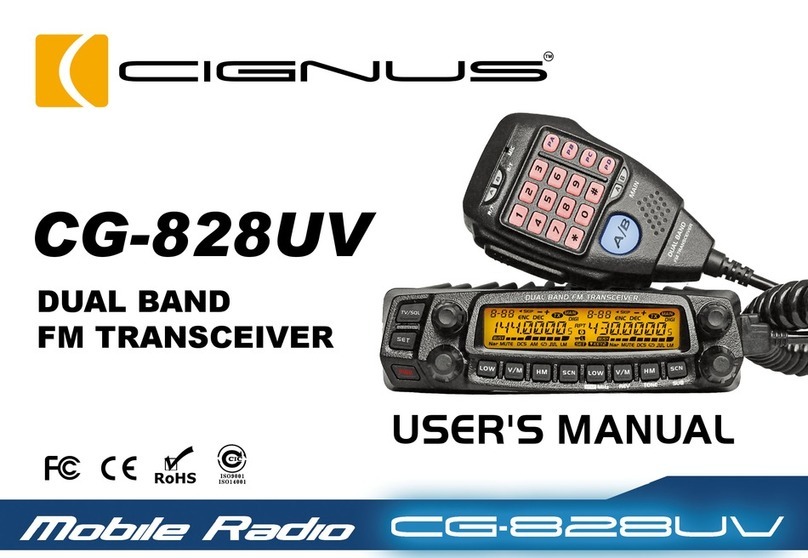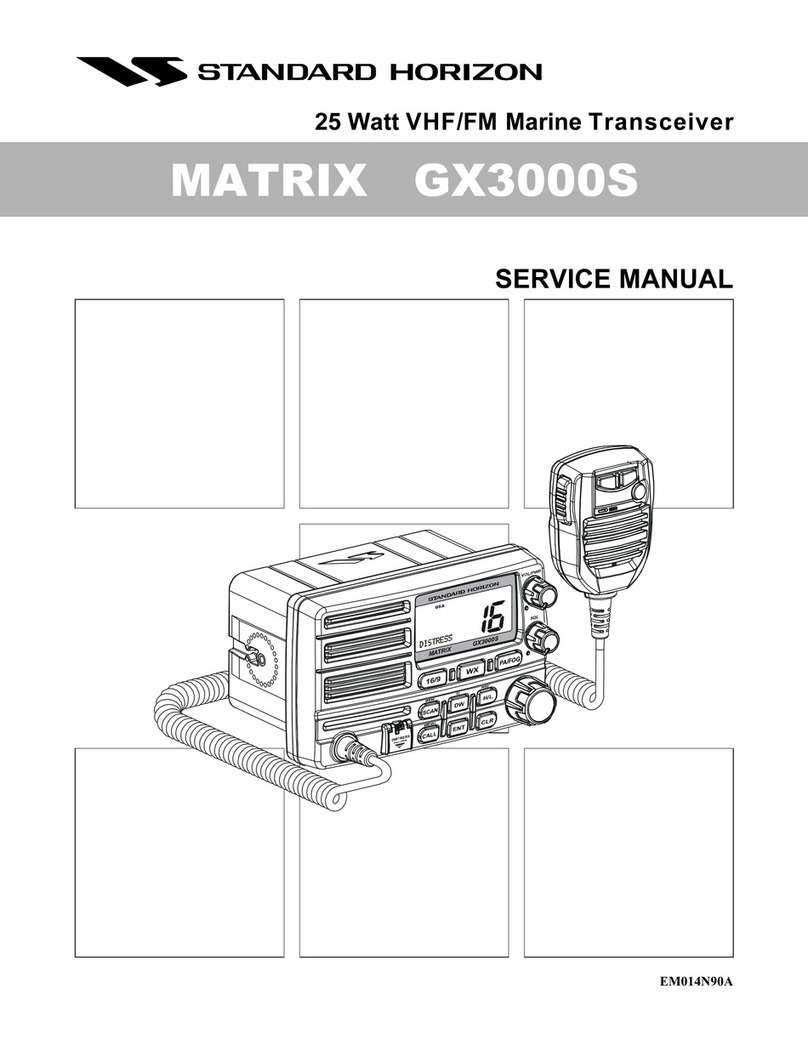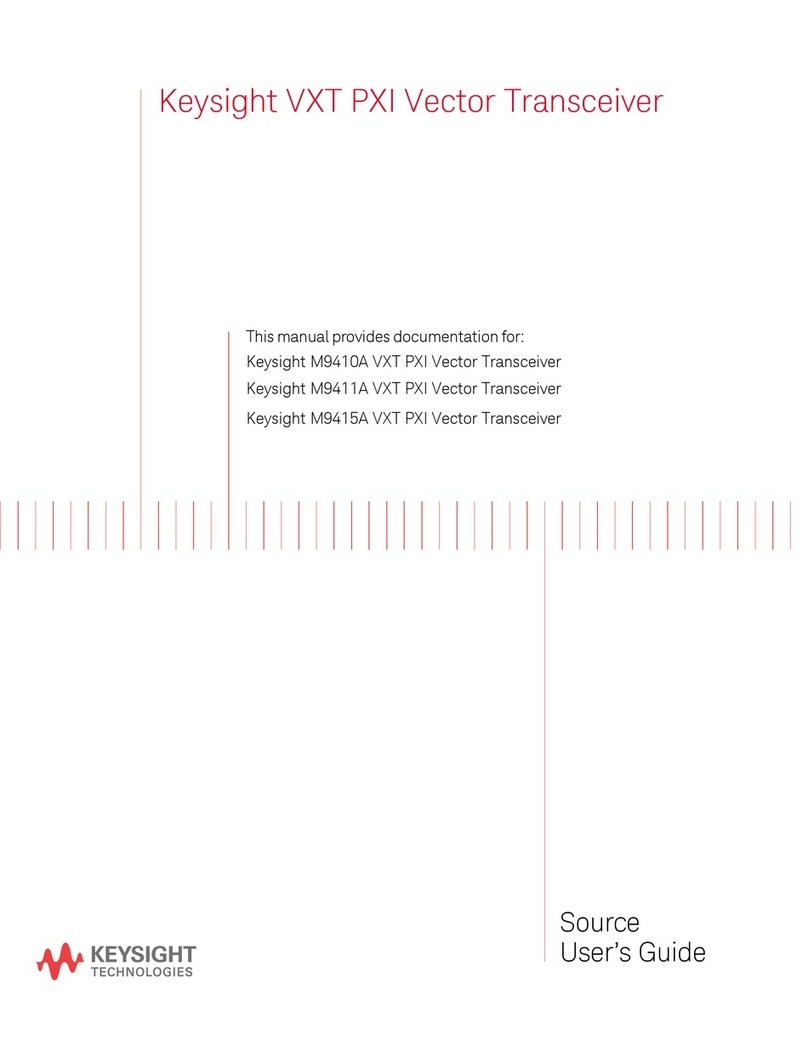Icom IC-F4SR User manual

iF4SR
UHF SRBR
INSTRUCTION MANUAL

i
FOREWORD
READ ALL INSTRUCTIONS carefully and completely
before using the transceiver.
SAVE THIS INSTRUCTION MANUAL —This in-
struction manual contains important operating instructions for
the IC-F4SR.
EXPLICIT DEFINITIONS
The explicit definitions below apply to this instruction manual.
CAUTIONS
RWARNING! NEVER hold the transceiver so that the
antenna is very close to, or touching exposed parts of the
body, especially the face or eyes, while transmitting. The
transceiver will perform best if the microphone is 5 to 10 cm
away from the lips and the transceiver is vertical.
RWARNING! NEVER operate the transceiver with a
headset or other audio accessories at high volume levels.
Hearing experts advise against continuous high volume op-
eration. If you experience a ringing in your ears, reduce the
volume level or discontinue use.
NEVER connect the transceiver to an AC outlet or to a
power source of more than 16 V DC. Such a connection will
damage the transceiver.
NEVER connect the transceiver to a power source that is
DC fused at more than 5 A. Accidental reverse connection will
be protected by this fuse, higher fuse values will not give any
protection against such accidents and the transceiver will be
ruined.
NEVER attempt to charge alkaline or dry cell batteries.Be-
ware that external DC power connections will charge batteries
inside the battery case.This will damage not only the battery
case but also the transceiver.
WORD
R
WARNING
CAUTION
NOTE
DEFINITION
Personal injury, fire hazard or electric
shock may occur.
If disregarded, inconvenience only. No risk
of personal injury, fire or electric shock.
Equipment damage may occur.
Versions of the IC-F4SR which display “CE”on the serial number
seal, comply with the essential requirements of the 89/336/EEC
directive for Electromagnetic Compatibility.

ii
DO NOT push the PTT when not actually desiring to trans-
mit.
DO NOT allow children to play with any radio equipment
containing a transmitter.
DO NOT operate the transceiver near unshielded electrical
blasting caps or in an explosive atmosphere.
AVOID using or placing the transceiver in direct sunlight or
in areas with temperatures below –20°C or above +55°C.
The use of non-Icom battery packs/chargers may impair
transceiver performance and invalidate the warranty.
Even when the transceiver power is OFF, a slight current still
flows in the circuits. Remove the battery pack or case from
the transceiver when not using it for a long time. Otherwise,
the battery pack or installed dry cell batteries will become ex-
hausted.
SUPPLIED ACCESSORIES
Accessories included with the transceiver: Qty.
qAntenna*1....................................................................... 1
wBelt clip ........................................................................... 1
eBattery pack or case attached to the transceiver*2......... 1
rWall charger*3................................................................. 1
t1922A REAR-SHEET (for dealer use) ........................... 1
*1Not supplied with some versions.
*2The battery pack (BP-195) or case (BP-194) may differ depend-
ing on version.
*3U.K. version with battery pack and all versions with battery case
do not include a wall charger.
+_
qw e
r
t

FOREWORD ...................................... i
EXPLICIT DEFINITIONS ................... i
CAUTIONS ......................................... i
SUPPLIED ACCESSORIES............... ii
TABLE OF CONTENTS .................... iii
1 ACCESSORY ATTACHMENT ..... 1
2 PANEL DESCRIPTION .......... 2–4
■Panel description ...................... 2
■Function display ........................ 4
3 BASIC OPERATION ............... 5–8
■Receiving and transmitting ....... 5
■Customizable keys .................... 6
■Lock function ............................ 6
■Monitor function ........................ 6
■All channel mode and select
channel mode ........................... 7
■Select channel setting .............. 7
■Display backlighting .................. 8
4 SCAN OPERATION .................... 9
■Scan types ................................ 9
■Starting a scan ......................... 9
5 RINGER FUNCTION .......... 10–11
■Ringer operation ..................... 10
■Ringer pattern ......................... 10
■Ringer timer ............................ 10
■Auto channel function ............. 11
■Auto reset timer ...................... 11
6 TONE SQUELCH/DTCS ..... 12–15
■Operation ................................ 12
■Setting a tone or code ............ 12
■Tone number indication .......... 13
■Pocket beep operation ............ 14
■Pocket beep pattern ................ 14
■Tone scan ............................... 15
7 OTHER FUNCTIONS ......... 16–17
■Power saver ............................ 16
■Confirmation beeps ................ 16
■Transmit lockout ...................... 16
■All reset ................................... 16
■“My name”function ................. 17
■Optional HM-75A functions ..... 17
8 BATTERY PACKS .............. 18– 20
■Charging precautions ............. 18
■Battery pack charging ............. 18
■About the battery pack ............ 20
■Installing batteries in the
battery case ............................ 20
9 TROUBLESHOOTING .............. 21
10 SPECIFICATIONS ..................... 22
11 OPTIONS ................................... 23
iii
TABLE OF CONTENTS

1
1
ACCESSORY ATTACHMENT
DAntenna
CAUTION: Transmitting without an
antenna may damage the transceiver.
Insert the supplied antenna into the an-
tenna connector and screw down the an-
tenna as shown at right.
Keep the jack cover attached when jacks
are not in use to avoid bad contacts from
dust and moisture.
DBattery pack replacement
To remove:
Push and hold the bat-
tery release downwards,
then pull the battery
pack upwards as shown
at right.
To attach:
Mate the notched ends of the battery pack and the trans-
ceiver, and push the battery pack until it clicks into place.
DBelt clip
Conveniently attaches to your belt.
To attach:
Slide the belt clip into the plastic loop on the back of the bat-
tery case/pack.
To remove:
Push the top of the belt clip towards the transceiver and at
the same time, push it downward and free of the plastic loop.

■Panel description qVOLUME CONTROLS [VOL] (p. 5)
Turns power ON and adjusts the audio level.
wPTT SWITCH [PTT] (p. 5)
Push and hold to transmit; release to receive.
eCHANNEL UP/DOWN KEYS [Y]/[Z]
➥Push to select the operating channel.(p. 5)
➥Push and hold to select the operating channel continu-
ously. (p. 5)
•The selection stops on channel 1 with a beep.
rKEY LOCK SWITCH [ ]
Toggles the lock function ON and OFF when pushed for 2
sec. (p. 6)
•“ ”appears when the lock function is activated.
tMONITOR KEY [?]
➥Push to toggle the receive tone/DTCS squelch ON or
OFF. (p. 12)
•“ ”appears when the receive tone/DTCS squelch is turned
OFF.
•This function is not available for some versions.
➥Monitors the selected channel when pushed and held.
(p. 6)
2
2PANEL DESCRIPTION
q
w
e
r
t
y
u
i
o
!0
!1
!2
!3
!4

3
2
PANEL DESCRIPTION
yCUSTOMIZABLE KEY 1 [ ] (p. 6)
uCUSTOMIZABLE KEY 2 [ ]
Activate the following customizable functions. 2 functions
can be programmed into the [ ]/[ ] key at power ON.
•These function cannot be changed depending on dealer setting.
[NULL] Null switch (backlight when used)
[CODE] CTCSS tone/DTCS code switch
[A/S] All/select channel switch (default of [ ])
[SCAN] Scan switch
[PO BEEP] Pocket beep switch
[MY NAME] “My name”switch (default of [ ])
[AUTO CH] Auto channel switch
iRINGER KEY [ ]
Transmits a ringer tone.
•1 of 10 ringer types can be selected at power ON.(p. 10)
•When the auto channel function is activated, pushing this key re-
peatedly transmits the ringer tone for the ringer time.
oFUNCTION DISPLAY (p. 4)
!0 TRANSMIT INDICATOR (p. 5)
Lights red while transmitting.
!1 EXTERNAL DC POWER JACK [CHARGE]
Connect a 12 to 16 V DC power source using the optional
cables, CP-12L or OPC-254L, to charge the attached bat-
tery pack; or connect the BC-110D (non-U.K. versions) wall
charger for charging.
CAUTION:This connection is for charging ONLY.
Power to the transceiver must be turned OFF during
charging.
!2 SPEAKER/MICROPHONE
!3 EXTERNAL SPEAKER AND MICROPHONE JACKS
[SP/MIC]
Connect an optional speaker-microphone or headset, if de-
sired. The internal microphone and speaker will not func-
tion when either is connected. (See p. 23 for a list of
available options.)
!4 ANTENNA CONNECTOR (p. 1)
Connects the supplied antenna.
NOTE: In this manual, the customizable keys are repre-
sented by the [f] icon. Operations which require a cus-
tomizable key observe the following style—
Push [f(FUNCTION)]
where “f”indicates the key is customizable and “FUNC-
TION”indicates the assigned function e.g.CODE, etc.

4
2PANEL DESCRIPTION
■Function display
qSELECT CHANNEL MODE INDICATOR (p. 7)
Appears when select channel mode is selected. Disap-
pears when all channel mode is selected.
wLOCK INDICATOR (p. 6)
Indicates that the lock function is in use.
eINVERSE DTCS CODE INDICATOR (p. 12)
Appears when setting an inverse DTCS code.
rTONE SQUELCH/DTCS INDICATOR (p. 12)
Appears when setting a tone squelch frequency or DTCS
code, etc.
tRINGER INDICATOR (p. 10)
“S”appears while transmitting a ringer signal.
yPOCKET BEEP INDICATOR (p. 14)
“ë”appears during pocket beep operation.
uRECEIVETONE/DTCS SQUELCH OFF INDICATOR
➥Appears when the receive tone/DTCS squelch is turned
OFF. (p. 12)
•This function is not available for some versions.
➥Appears when the monitor function is in use.(p.6)
iLOW BATTERY INDICATOR
➥Appears when the battery is nearing exhaustion.
➥Appears and flashes when battery replacement is nec-
essary.
oCHANNEL READOUT
Shows the operating channel, tone frequency, DTCS code,
set mode contents, etc.
!0 BUSY AND SIGNAL INDICATORS
➥“BUSY”appears when receiving a signal or when the
squelch is open.
➥The signal indicators show the relative signal strength
while receiving.
!1 NON-SELECT CHANNEL INDICATOR (p. 7)
Appears when a non-select channel is selected.
MR
BUSY
T SQL
SKIP
!0
qwe r y iut
o
!1 !0

5
3
BASIC OPERATION
■Receiving and transmitting
CAUTION: Transmitting without an antenna may dam-
age the transceiver.
qRotate [VOL] clockwise to turn power ON, then set to the
10 o’clock position.
•If “ë”appears on the display, push [f(PO BEEP)] to cancel the
pocket beep. (p. 14)
wSelect the desired channel with the [Y]/[Z] switches.
•When receiving a signal, “BUSY”appears and audio is emitted
from the speaker.
•Further adjustment of [VOL] may be necessary at this point.
•Push [?] to toggle the tone squelch ON and OFF. (p. 12, This
function is not available for some versions.)
•Push and hold [?] to monitor the operating channel. (p. 6)
ePush and hold [PTT] to transmit, then speak into the mi-
crophone.
•Transmit indicator lights.
rRelease [PTT] to receive.
IMPORTANT: To maximize the readability of your transmit-
ted signal, pause a few sec. after pushing [PTT], hold the
microphone 10 to 15 cm from your mouth and speak at a
normal voice level.
NOTE: The transceiver has a power save function to con-
serve battery power.The power save function activates au-
tomatically when no signal is received for 5 sec.
qSet volume
wMonitor switch
eSpeak into
microphone
ePush to transmit
rRelease to
receive
wSelect channel

6
3BASIC OPERATION
■Customizable keys
The customizable keys activate the following functions. 2
functions can be programmed into the [ ]/[ ] key at power
ON. Assign the desired function as follows:
•This function is not available depending on dealer setting.
Usable functions:
[NULL] Null switch (backlight when used)
[CODE] CTCSS tone/DTCS code switch
[A/S] All/select channel switch (default of [ ])
[SCAN] Scan switch
[PO BEEP] Pocket beep switch
[MY NAME] “My name”switch (default of [ ])
[AUTO CH] Auto channel switch
qWhile pushing [Y] + [ ] or [Y] + [ ], turn power ON to
change the function of the customizable key.
•The selected function name is displayed for a moment.
•Functions can be selected in the above order.
wTurn power OFF.
eRepeat steps qand wuntil the desired function is se-
lected.
■Lock function
The lock function prevents accidental channel changes and
accidental function access. [PTT], [?] and the backlight func-
tion can be used while the lock function is in use.
➥Push [ ] for 2 sec. to toggle the lock function ON and
OFF.
■Monitor function
This function is used to listen to weak signals or to open the
tone squelch manually.
➥Push and hold [?] to monitor the operating channel.
MR
“”appears when the
lock function is in use.
BUSY
“”and “”appear when
the monitor function is in use.
BUSY

7
3
BASIC OPERATION
■All channel mode and select
channel mode
The transceiver has 2 indication modes—all channel mode
and select channel mode.
Select channel mode provides easy, fast channel selection
and speeds up the scan interval. Non select channels are not
displayed while in select channel mode.
➥Push [f(A/S)] to toggle all channel mode or select channel
mode.
•“X”appears when the select channel mode is selected.
■Select channel setting
Setting a channel as the select channel provides easy, fast
channel selection and speeds up the scan interval.
qPush [f(A/S)] to select all channel mode.
•“X”disappears.
wSelect the desired channel with the [Y]/[Z] switches.
ePush [f(A/S)] for 2 sec.to toggle the channel between se-
lect channel and non-select channel.
•“SKIP”disappears for a select channel.
MR A/S
momentarily
Appears during select mode
SKIP
A/S
for 2 sec.
Appears for
non-select channels

8
3BASIC OPERATION
■Display backlighting
The transceiver has display backlighting with a 5 or 10 sec.
timer for nighttime operation. The display backlighting can be
turned ON continuously or turned OFF, if desired.
➥Push any switch except [PTT] to turn the backlighting ON.
•When the 5 or 10 sec. timer is set, the backlighting will automat-
ically turn OFF when switches have not been operated for 5 or 10
sec., respectively.
DSetting the backlighting timer
qWhile pushing [Y] + [?], turn power ON to enter set mode.
•Set mode is not available depending on dealer setting.
wPush [?] several times until “LI”appears.
ePush [Y] or [Z] to select the backlighting timer.
rTurn power OFF to exit set mode.
5 sec. timer
10 sec. timer
Continuously ON
Continuously OFF
[

9
4
SCAN OPERATION
■Scan types
Scanning is an efficient way to locate signals quickly over all
channels.
Setting select channels and using select channel mode (p.7)
speed up the scanning interval.
In addition, the auto channel function is available for standby
convenience. (p. 11)
■Starting a scan
To speed up the scanning interval, set desired channels as
select channels and set select channel mode in advance. (p.
7)
qPush [f(SCAN)] to start the scan.
•Decimal point flashes while scanning.
wWhen receiving a signal, scan pauses and resumes ac-
cording to the included CTCSS frequency or DTCS tone.
(p. 12)
•When the code is matched, scan resumes 5 sec.after the signal
disappears.
•When the code is not matched, scan resumes immediately.
ePush [f(SCAN)] to stop the scan.
Repeatedly scans all channels including non-select
channels in sequence.
Repeatedly scans select channels only, in sequence.
SCAN in all channel mode
SCAN in select channel mode
ch 24
ch 01 ch 02 ch 03
SKIP
SKIPSKIP ch 04
ch 05ch 06ch 23
ch 24
ch 01 ch 02
ch 04
ch 06
Flashes while scanning.

10
5RINGER FUNCTION
■Ringer operation
The ringer function is used to call a waiting station with a ring
or similar tones.10 kinds of ring tones are available.
qSelect the desired channel with the [Y]/[Z] switches.
wPush [ ] for a desired time to call the waiting station.
•“S”appears while transmitting a ring tone.
•The ringer tones are repeatedly transmitted when this key is
pushed and held.
eWaiting station receives the ringer tones.
rOperate the transceiver in the normal way.
■Ringer pattern
10 ringer patterns are available. Select the desired ringer pat-
tern as follows:
qWhile pushing [Z] + [ ], turn power ON to enter ringer
pattern set mode.
•“RG”and the selected ringer pattern
number appear.
wPush [Y] or [Z] to select the
ringer pattern.
•The selected pattern is played once.
eTurn power OFF to exit set
mode.
■Ringer timer
Ringer time is the minimum transmission time of the ringer
tones when the auto channel function is in use. 0 to 16 sec.in
1 sec. steps can be programmed.
qWhile pushing [Y] + [?], turn power ON to enter set mode.
•Set mode is not available depending on dealer setting.
wPush [?] several times until “Rt”appears.
ePush [Y] or [Z] to select the ringer timer.
rTurn power OFF to exit set mode.
The minimum transmit time can be set greater than the wait-
ing period of the auto channel function. (p. 11) The recom-
mended ringer time depends on the number of receive
stations:
2 or 3 channels 2 sec.
4 or 5 channels 3 sec.
6 or 7 channels 4 sec.
[
[
Ringer pattern 3
2 sec. ringer time

■Auto channel function
The auto channel function automatically checks for calling sig-
nals or ringer signals on all or select channels.
If you hear ringer tone, specified in set mode, you can answer
the call by simply pushing the [PTT] switch. It is not neces-
sary to select a channel first.
qPush [f(AUTO CH)] to turn the auto channel function ON.
•“A”appears and scan starts.
wWhen receiving a ringer tone, push [PTT] to answer.
eTo call a waiting station, push [ ] to transmit a ringer
tone.
•To call a waiting station by voice, push [PTT] until beep tones
sound (for longer than the ringer time), then speak into the mi-
crophone.
rWhen the auto reset timer is turned OFF, push [f(AUTO
CH)] to restart the auto channel function.
tPush [f(AUTO CH)] to cancel the function.
■Auto reset timer
Auto reset time is the period before the auto channel function
restarts after a busy signal disappears and in which no oper-
ation is performed while the auto channel function is in use.
5 to 60 sec. in 5 sec. steps or OFF can be programmed.
qWhile pushing [Y] + [?], turn power ON to enter set mode.
•Set mode is not available depending on dealer setting.
wPush [?] several times until “AR”appears.
ePush [Y] or [Z] to select the auto reset time or to turn the
function OFF.
rTurn power OFF to exit set mode.
11
5
RINGER FUNCTION
“A”appears while the auto
channel function is in use.
[
5 sec. auto reset time Auto reset timer is cancelled.

12
6TONE SQUELCH/DTCS
■
Operation
By default, the transceiver uses a CTCSS/DTCS squelch sys-
tem. The CTCSS tone squelch/DTCS opens only when re-
ceiving a signal containing a matching tone.You can silently
wait for calls from group members using the same tone.
qPush [Y] or [Z] to select the desired channel.
wSet the desired tone or code as described at right.
ePush [?] to turn the receive tone squelch ON.
•“ ”disappears when the tone squelch is turned ON.
•Tone squelch or DTCS is always turned ON for some versions.
rWhen the received signal includes a matching tone,
squelch opens and the signal can be heard.
•When the received signal’s tone does not match, tone squelch
does not open, however, the S-indicator shows signal strength.
•To open the squelch temporarily, push and hold [?].
NOTE:The transceiver has 50 CTCSS tone frequencies
and consequently their spacing is narrow compared with
units having 38 tones. Therefore, some tone frequencies
may receive interference from adjacent tone frequencies.
Tone frequencies or DTCS code settings are automatically
stored in memory channels for easy recall.
■Setting a tone or code
50 CTCSS tones and 84 DTCS codes are available.
qPush [Y] or [Z] to select a channel.
wPush [f(CODE)].
•Current tone or code appears.
ePush [Y] or [Z] to select the
CTCSS tone frequency or
DTCS code.
•“–” appears when an inverse
DTCS code is selected.
rPush [f(CODE)] to exit.
CTCSSTONE FREQUENCY (Unit: Hz)
No. Freq. No. Freq. No. Freq. No. Freq. No. Freq.
01
02
03
04
05
06
07
08
09
10
67.0
69.3
71.9
74.4
77.0
79.7
82.5
85.4
88.5
91.5
11
12
13
14
15
16
17
18
19
20
194.8
197.4
100.0
103.5
107.2
110.9
114.8
118.8
123.0
127.3
21
22
23
24
25
26
27
28
29
30
131.8
136.5
141.3
146.2
151.4
156.7
159.8
162.2
165.5
167.9
31
32
33
34
35
36
37
38
39
40
171.3
173.8
177.3
179.9
183.5
186.2
189.9
192.8
196.6
199.5
41
42
43
44
45
46
47
48
49
50
203.5
206.5
210.7
218.1
225.7
229.1
233.6
241.8
250.3
254.1
T SQL
Channel
number
Inverse DTCS code
indication
Tone frequency
or DTCS code

13
6
TONE SQUELCH/DTCS
DTCS CODE
■Tone number indication
The transceiver can display CTCSS tones and DTCS codes
using 2-digit numbers.
CTCSS tones are indicated as 01 to 50. DTCS codes are in-
dicated as A0 to A9, B0 to B9, etc. as shown at left.
DSetting tone number indication
ON/OFF
qWhile pushing [Y] + [?], turn power ON to enter set mode.
•Set mode is not available depending on dealer setting.
wPush [?] several times until “to”appears.
ePush [Y] or [Z] to turn the tone number indication ON or
OFF, respectively.
•“nUm”:
Tone frequency and DTCS
code are displayed by number.
•“CodE”:
Tone frequency and DTCS
code are displayed by code.
rTurn power OFF to exit set
mode.
No. Code No. Code No. Code No. Code No. Code
F0
F1
F2
F3
F4
F5
F6
F7
F8
F9
371
411
412
413
423
431
432
445
464
465
G0
G1
G2
G3
G4
G5
G6
G7
G8
G9
466
503
506
516
532
546
565
606
612
624
H0
H1
H2
H3
H4
H5
H6
H7
H8
H9
627
631
632
654
662
664
703
712
723
731
I0
I1
I2
I3
732
734
743
754
A0
A1
A2
A3
A4
A5
A6
A7
A8
A9
023
025
026
031
032
036
043
047
051
054
B0
B1
B2
B3
B4
B5
B6
B7
B8
B9
065
071
072
073
074
114
115
116
125
131
C0
C1
C2
C3
C4
C5
C6
C7
C8
C9
132
134
143
152
155
156
162
165
172
174
D0
D1
D2
D3
D4
D5
D6
D7
D8
D9
205
223
226
243
244
245
251
261
263
265
E0
E1
E2
E3
E4
E5
E6
E7
E8
E9
271
306
311
315
331
343
346
351
364
365
Tone number indication OFF
Tone number indication ON
[

14
6TONE SQUELCH/DTCS
■Pocket beep operation
By default, the transceiver uses a CTCSS/DTCS squelch sys-
tem. Using this system, you can determine that someone has
called while you were away from the transceiver—much like a
“common pager.”
DWaiting for a call from a specific station
qSelect the desired channel with the [Y]/[Z] switches.
•If “”appears, push [?] to turn the tone decoder ON. (p.12)
wSet the desired tone or code.
•See p. 12 for programming information.
ePush [f(PO BEEP)] to activate the pocket beep. (p.14)
•“ë”appears in the function display.
rWhen a signal with the correct tone is received, the trans-
ceiver emits beep tones and flashes “ë.”
tPush [PTT] to answer or push [f(PO BEEP)] to stop the
beeps and flashing.
DCalling a waiting station using pocket beep
A tone or code matched with the station’s tone frequency is
necessary.
qSelect the desired channel with the [Y]/[Z] switches.
wSet the desired tone or code.
ePush [PTT] to call the waiting station.
rWait for the answer back call.
■Pocket beep pattern
The pocket beep pattern, when receiving a matched CTCSS
tone/DTCS code, can be selected from 6 patterns.
DSetting the pocket beep pattern
qWhile pushing [Z] + [II], turn power ON to enter the pocket
beep pattern setting condition.
wPush [Y] or [Z] to select the desired pocket beep pattern.
•1 1 high beep once.
•2 2 high beeps once.
•3 1 high and 1 low beep 3 times.
•4 1 high beep repeated at fixed intervals.
•5 2 high beeps repeated at fixed intervals.
•6 1 high, 1 low beep 3 times, repeated at fixed intervals.
eTurn power OFF to exit set mode.
Pocket beep pattern 3

■Tone scan
The transceiver can detect the tone frequency or DTCS code
in a received signal.By monitoring a signal that is being trans-
mitted on the channel, you can determine the tone or code
required to open the receiving station’s squelch.
qPush [Y] or [Z] to select the desired channel.
wPush [f(CODE)] for 2 sec. to start tone scan.
eWhen a matched tone or code is detected, the tone scan
stops automatically.
•The detected tone or code is automatically memorised into the
channel.
rPush [f(CODE)] to cancel the tone scan, if necessary.
15
6
TONE SQUELCH/DTCS
T SQL
Flashes while scanning.
Selected channel number

16
7OTHER FUNCTIONS
■Power saver
The power saver function reduces the current drain to con-
serve battery power.
qWhile pushing [Y] + [?], turn power ON to enter set mode.
•Set mode is not available depending on dealer setting.
wPush [?] several times until “PS”appears.
ePush [Y] or [Z] to turn the power saver ON or OFF, re-
spectively.
rTurn power OFF to exit set mode.
■
Confirmation beeps
You can select silent operation by turning beep tones OFF or
you can have confirmation beeps sound at the push of a
switch by turning beep tones ON. The beep tone volume is
linked with [VOL].
qWhile pushing [Y] + [?], turn power ON to enter set mode.
•Set mode is not available depending on dealer setting.
wPush [?] several times until “bE”appears.
ePush [Y] or [Z] to turn the confirmation beeps ON or OFF,
respectively.
rTurn power OFF to exit set mode.
■Transmit lockout
The transmit lockout function inhibits transmission while re-
ceiving a signal.
qWhile pushing [Y] + [?], turn power ON to enter set mode.
•Set mode is not available depending on dealer setting.
wPush [?] several times until “Lo”appears.
ePush [Y] or [Z] to turn the transmit lockout function ON or
OFF, respectively.
•“bUSy”:
Transmission is impossible
when receiving a signal.
•“oFF”:
Transmission is always possi-
ble.
rTurn power OFF to exit set
mode.
■All reset
Reset the CPU when the internal CPU malfunctions.
•All reset may not be available depending on dealer setting.
qWhile pushing [Y], [Z] and [ ], turn power ON.
wRelease [Y], [Z] and [ ] after “CLEAR”disappears.
CAUTION:Resetting the CPU returns all programmed con-
tents to their default settings.
Lockout function is cancelled.
Transmission is impossible
when receiving a signal.
[
[
[
Table of contents
Other Icom Transceiver manuals
